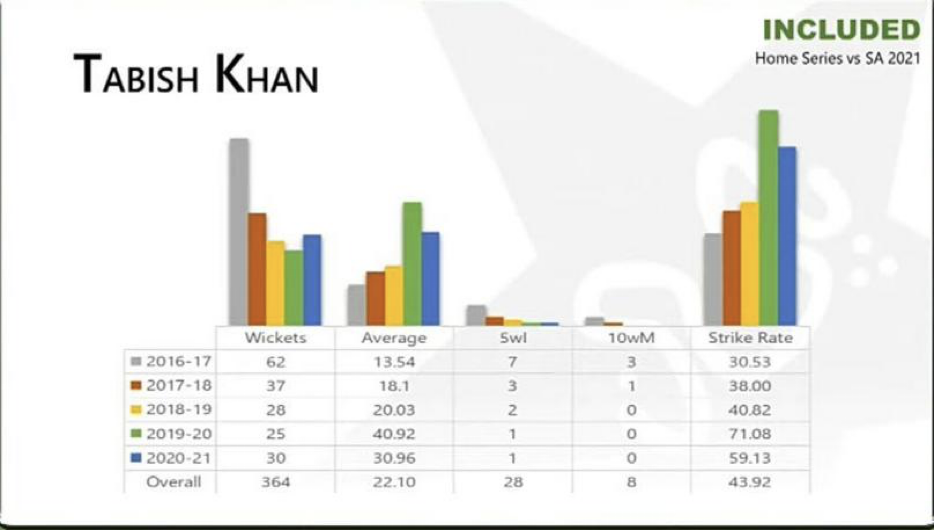
Squad Selection on Merit or Popular Choice
Was the Data-Based Squad Selection on Merit or by Popular Choice?
After a torrid tour of New Zealand that ended with more questions than answers, team Pakistan’s next assignment is at home against the Proteas, who are visiting Pakistan for the first time since 2007. A horrific overseas tour followed by all sorts of media speculations is not an uncommon story in Pakistan cricket. Before the home series formally begins on 26th January with the first Test match in Karachi, most fans were anxiously anticipating the squad announcement, which was to be made by the newly appointed Chairman of Selectors Mohammad Wasim. There were question marks over a few players who failed to deliver in New Zealand and whether the domestic performers will get a chance or not.
As the press conference for the squad announcement began, the first noticeable point was the Chief Selector using a data-based approach to justify the team selection and players dropped from the squad. As fresh and welcoming this new strategy was, it seemed to have divided the fans into two different schools of thought. One set of fans seem completely happy with the fact that proven domestic performers were selected, while the other critiques a lot of bias shown while putting up the data of the players that were selected.
Panicked Selection?
Although the Chief Selector refuted the statement about the selection being panic-based, in my opinion, he did not provide enough proof to include certain players, and the data that was shown to justify their inclusion seemed biased. Even though top performers of the recently concluded FC season or the last two years were preferred, the selection was more like a popular demand thing to make most people happy rather than being on merit. It also felt that some of the players were picked on personal instinct. The Chief Selector, albeit giving ample reasoning for their inclusion, was negating his own statements that he gave earlier in the presser to justify the inclusion of a few players.
Let me now break down point-by-point how the new “data-based” team selection was not on merit but rather on popular choice under media pressure.
Tabish Khan
The 36-year-old Karachi born fast bowler has over 17 years of FC experience with 598 wickets to his name from 137 matches. He has represented Pakistan ‘A’ on numerous occasions but has been the most unfortunate of the top domestic performers to have never had an opportunity to represent Pakistan at the international level. Any argument over his selection seems dull considering what he has achieved and how deserving he is to at least wear the green cap once in his life after years of hard work in the domestic circuit. Still, his inclusion in the recent Test squad over Sohail Khan seems unjustified. While presenting the chart of Tabish Khan’s performance, the Chief Selector was of the view that “all of us know how good his performances have been in the last five years.”
Let us look at that chart of Tabish Khan’s performance that was provided by the Chief Selector:
First of all, there are quite a few errors in the chart itself, which shows the overall wickets tally as 364 when the total number of wickets picked by Tabish in the last five years is 182, as given in the wickets column. The 5wI column shows 28 5fers, but the overall number is 14. Meanwhile, the 10wM column has 8, but the sum is actually 4. Still, having mentioned these errors, I feel that these types of mistakes can be forgivable as we know that this does not change the fact that Tabish has been phenomenal over the years.
The debating point here is that even if we go by the following chart, Tabish Khan’s performances in the last two seasons (since the domestic cricket revamp) have only receded as he averages 35.94 with the ball at a strike rate of 65.10. If we compare these recent performances with another top performer like Waqas Maqsood, the selection seems unjustified and based on media pressure rather than merit alone.
Tabish vs. Waqas – Comparison of performances in the last two years (Since revamp)
| Player | Matches | Wickets | Average | 5wI | Economy | Strike Rate |
| Tabish Khan | 19 | 55 | 35.49 | 2 | 3.30 | 64.6 |
| Waqas Maqsood | 16 | 51 | 26.88 | 1 | 3.04 | 53.1 |
This clearly proves that Waqas Maqsood has been the better of the two bowlers and more consistent. It is quite alarming that the selection committee could not evaluate the data of Waqas Maqsood, whereas they made a case for Tabish Khan over the same data.
Anyways, moving on from this point to the other, we will now look at how some of the exclusions were perhaps too harsh, or the reasoning given for those exclusions cannot be justified.
Sohail Khan
From the past year or so, Sohail Khan has been a regular member of the Test squad but could not get a game ahead of the trio of Shaheen, Abbas & Naseem. The 37-year-old medium-fast bowler was perhaps the unluckiest of all the players to be dropped after just warming the bench for the past year and not even getting a game. The Chief Selector explained his exclusion from the team by saying that he is “definitely in our plans, but we think that in our home conditions, Tabish is a better bowler than Sohail.”
Now let’s get the facts straight. Even though Sohail missed almost all of the 2020 season due to the international assignment with the Test team, his numbers are still better than Tabish in the same conditions where the Chief Selector deemed him less threatening than Tabish.
Sohail vs. Tabish- Comparison of performances in the last two years
| Player | Matches | Wickets | Average | 5wI | Economy | Strike Rate |
| Tabish Khan | 19 | 55 | 35.49 | 2 | 3.30 | 64.6 |
| Sohail Khan | 11 | 30 | 34.07 | 0 | 3.33 | 61.4 |
The above table proves that it was quite baffling on the Chief Selector’s behalf to give a statement like that to exclude a player from the squad when all of the stats suggest that he has been better of the two in home conditions.med him less threatening than Tabish.
The Curious Case of Zafar Gohar
It came as a surprise to a lot of people that the young all-rounder was dropped after making his debut in the last Test in New Zealand. Zafar was named the player of the tournament of 2019-2020 FC season after his brilliant all-round performances and did reasonably well with the bat in both of the innings on his debut, scoring 34 & 37. His struggle with the ball in conditions that were not ideal for spin-bowling was not much of a surprise given that our premium spinner Yasir Shah had also struggled in the 1st Test. However, to drop him from the squad in place of Mohammad Nawaz made no sense for several reasons:
- It is harsh to drop a player based on the performance of a single Test match where many would argue that he did reasonably well.
- The statement to justify his exclusion was that “Zafar is definitely in our white-ball plans, but right now, we feel he needs some time with the red ball to develop his game for the longer format further.”
- The player he was replaced with, i.e. (Mohammad Nawaz) has played a similar number of FC games.
- Had Zafar not missed out on this season’s matches, then the number of FC matches for both the players would have been similar.
- While Zafar has a far better bowling record in FC cricket, Nawaz is the exact opposite as he is far ahead with the bat. However, he doesn’t bowl nearly as much as Zafar in the longer format. The fact remains that Zafar was hard done by and the reason given for his exclusion was quite strange.
| Player | Matches | Wickets | Bowl Average | Bat Average | 50s | 100s |
| Zafar Gohar | 40 | 144 | 29.67 | 22.19 | 5 | 1 |
| Mohammad Nawaz | 52 | 87 | 29.60 | 37.47 | 15 | 6 |
The Usman Salahuddin Dilemma
As refreshing it was to see FC performers being preferred, it was hard to accept that Salman Ali Agha and Mohammad Nawaz were named in the squad when both play a similar role in the batting all-rounder. Simultaneously, the seasoned campaigner Usman Salahuddin missed out after being the most consistent batsman in the domestic circuit for the past few years.
Usman had the best average in the last six years out of all the batsmen who were competing for a place in the Test squad.
| Name | Inns | Runs | Avg | 100 | 50 |
| Usman Salahuddin | 78 | 3225 | 48.86 | 8 | 21 |
| Saud Shakeel | 71 | 2994 | 48.29 | 10 | 15 |
| Imran Butt | 82 | 2667 | 33.76 | 6 | 13 |
| Iftikhar Ahmed | 64 | 2550 | 42.50 | 8 | 12 |
| Salman Ali Agha | 76 | 2536 | 37.29 | 6 | 13 |
| Kamran Ghulam | 46 | 2063 | 47.98 | 8 | 9 |
| Asad Shafiq | 52 | 1926 | 45.86 | 3 | 15 |
The stats above clearly prove that Usman Salahuddin has been the best and most consistent of the batsmen in domestic circuit. It is astonishing that the selectors didn’t consider his performances or they preferred others over him. Leaving him out of the squad is not the worst thing the selectors have done because his alternatives have been good too, but the question here is that how can the selection criteria be so different for one player and completely different for the other?
The Inclusion of Two Rookies
Another point worth noting is the inclusion of Abdullah Shafique and Haris Rauf in the squad. While there is no doubt on the ability of both the youngsters, the primary concern is that when stats and data were supposed to be the new norm of selection, how can someone get into the team with little to no experience?
A couple of days before the squad announcement, Mohammad Wasim had given an interview where he said that “we have come up to a conclusion that from now on all the development work of a player will be done in the National High-Performance Centre as we have many big names working as coaches at the NHPC now.” Then, two days later, he picks two relatively inexperienced players citing them as “long term prospects” when both of them have a collective experience of 4 FC matches between them with their last appearance at the FC level almost a year ago. In addition to that, it doesn’t bode well for the player you dropped with the remarks that “he probably needs more experience with the red ball,” while at the other end of the spectrum, you are selecting players with the least experience of FC cricket.
Haris Rauf
Two recently concluded away tours saw the young bowling attack coming under heavy criticism. Their selection based on very little FC experience was being labeled as the “worst” in the history of Pakistan cricket. Although I get the point that Mohammad Wasim wanted to make while justifying their selection, it is still hard to digest the fact that Haris Rauf, with 3 FC games and no experience of FC cricket in the past year, is now being considered for Test selection based on his “pace,” who was until very recently being viewed as a potent threat in “white-ball” cricket. Also, how can we determine (based on 3 FC games and 76 overs in total) that a bowler is good enough to bowl in the mid-140s consistently once he gets into his 2nd or 3rd spell in a day of Test cricket?
Abdullah Shafique
Abdullah Shafique’s stats shown on the projector were quite misleading as he has only featured in 1 FC match where he scored a 100, but the rest of the stats were perhaps piled up from the 2nd XI games in which he had participated last year. His addition to the Test squad may not be a bad one considering his style of play, which is more suited to the longer format, but the selection is still questionable. The problem about picking Abdullah in the squad is not his selection but the statements Mohammad Wasim gave about player development and how players were not going to be developed with the team but rather at NHPC. Furthermore, the Chief Selector explained the selection as a “long-term” solution for the batting woes as he felt the youngster was “solid and a compact-enough player to thrive at the top-level.”
Squad Members or Player Development?
Although both youngsters have enough talent to become genuine assets for the Test side, knowing that they are highly unlikely to make their way into the playing XI, one can assume that they are a part of the squad grooming/developing purposes. Thus, the Chief Selector’s statement before the squad’s announcement and then the justification of the inclusion makes it very difficult not to criticize their selection.
Another question that arises here is, if Abdullah and Haris were included looking at the long-term aspect while selecting the squad, how long are 36-year-old fast bowlers and 34-year-old spinners supposed to serve us at the Test level? If they are not going to be part of the squad come the next big away tour, will we be again relying on youngsters to dig us out of trouble in foreign conditions?
Conclusion
The team that has been selected has a lot of deserving performers from FC cricket, but the fact is that a few of them might be too old now to represent Pakistan in the longer run. Additionally, a few of the exclusions were too harsh and not justified.
Hence, this selection seems more panic-based rather than going by statistical data to include players that were already on the horizon. The data was, therefore, in my opinion, used to justify the selections that were the popular choice, and it feels as if the lesser-hyped FC performers were neglected.
On the other hand, dropping players without them getting a fair chance at the international level and then giving inappropriate justifications of their exclusion was perhaps the downside to all the factors discussed above.
Despite the squad having nine uncapped players, it is still loaded with FC performers. We can hope that they will topple the South African unit on spin-friendly tracks and register another home victory. That will help nullify all the talk about players’ ages, and they will prove their worth on the international level after years of hard work on the domestic scene.
The opinions expressed solely belong to the writer and do not necessarily reflect the views of Grassroots Cricket.










Leave a Reply